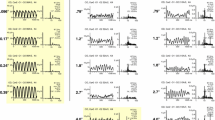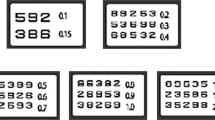Abstract
Purpose
Acuity-VEP approaches basically all use the information obtained across a number of check sizes (or spatial frequencies) to derive a measure of acuity. Amplitude is always used, sometimes combined with phase or a noise measure. In our approach, we employ steady-state brief-onset low-contrast checkerboard stimulation and obtain amplitude and significance for six different check sizes, yielding 12 numbers. The rule-based “heuristic algorithm” (Bach et al. in Br J Ophthalmol 92:396–403, 2008. https://doi.org/10.1136/bjo.2007.130245) is successful in over 95% with a limit of agreement (LoA) of ± 0.3LogMAR between behavioral and objective acuity for 109 cases. We here aimed to test whether machine learning techniques with this relatively small dataset could achieve a similar LoA.
Methods
Given recent advances in machine learning (ML), we applied a wide class of ML algorithms to this dataset. This was done within the “caret” framework of R using altogether 89 methods, of which rule-based and multiple regression approaches performed best. For cross-validation, using a jackknife (leave-one-out) approach, we predicted each case based on an ML model having been trained on all remaining 108 cases.
Results
The ML approach predicted visual acuity well across many different types of ML algorithms. Using amplitude values only (discarding the p values) improved the outcome. Nearly half of the tested ML algorithms achieved an LoA better than the heuristic algorithm; several “Random Forest”- or “multiple regression”-type algorithms achieved an LoA of below ± 0.3. In the cases where the heuristic approach failed, acuity was predicted successfully. We then applied the ML model trained with the Bach et al. [1] dataset to a new dataset from 2018 (78 cases) and found both for the heuristic algorithm and for the ML approach an LoA of ± 0.259, a nearly one-line improvement.
Conclusions
The ML approach appears to be a useful alternative to rule-based analysis of acuity-VEP data. The achieved accuracy is comparable or better (in no case the ML-based acuity differed more than ± 0.29 LogMAR from behavioral acuity), and testability is higher, nearly 100%. Possible pitfalls are examined.





Similar content being viewed by others
References
Bach M, Maurer JP, Wolf ME (2008) Visual evoked potential-based acuity assessment in normal vision, artificially degraded vision, and in patients. Br J Ophthalmol 92:396–403. https://doi.org/10.1136/bjo.2007.130245
Strasburger H, Scheidler W, Rentschler I (1988) Amplitude and phase characteristics of the steady-state visual evoked potential. Appl Opt 27:1069–1088
Joost W, Bach M (1990) Variability of the steady-state visually evoked potential: interindividual variance and intraindividual reproducibility of spatial frequency tuning. Doc Ophthalmol 75:59–66
Bach M, Meigen T (1999) Do’s and don’ts in Fourier analysis of steady-state potentials. Doc Ophthalmol 99:69–82
Meigen T, Bach M (1999) On the statistical significance of electrophysiological steady-state responses. Doc Ophthalmol 98:207–232
R Development Core Team (2014) R: A Language and Environment for Statistical Computing. http://www.R-project.org. Accessed 18 Aug 2014
RStudio Team (2015) (2015). RStudio: Integrated Development for R. http://www.rstudio.com/. Accessed 21 Oct 2018
Kuhn M (2018) caret (Classification and Regression Training) R package that contains misc functions for training and plotting classification and regression models: topepo/caret. https://github.com/topepo/caret. Accessed 21 Oct 2018
Heinrich SP, Bock CM, Bach M (2016) Imitating the effect of amblyopia on VEP-based acuity estimates. Doc Ophthalmol 133:183–187. https://doi.org/10.1007/s10633-016-9565-7
Knötzele J, Heinrich SP (2019) Can VEP-based acuity estimates in one eye be improved by applying knowledge from the other eye? Doc Ophthalmol. https://doi.org/10.1007/s10633-019-09700-y (in press)
Bland JM, Altman DG (1999) Measuring agreement in method comparison studies. Stat Methods Med Res 8:135–160. https://doi.org/10.1177/096228029900800204
Hoffmann MB, Brands J, Behrens-Baumann W, Bach M (2017) VEP-based acuity assessment in low vision. Doc Ophthalmol 135:209–218. https://doi.org/10.1007/s10633-017-9613-y
Wenner Y, Heinrich SP, Beisse C et al (2014) Visual evoked potential-based acuity assessment: overestimation in amblyopia. Doc Ophthalmol 128:191–200. https://doi.org/10.1007/s10633-014-9432-3
Heinrich SP, Bock CM, Bach M (2016) Imitating the effect of amblyopia on VEP-based acuity estimates. Doc Ophthalmol 133:183–187. https://doi.org/10.1007/s10633-016-9565-7
Kushner BJ, Lucchese NJ, Morton GV (1995) Grating visual acuity with Teller cards compared with Snellen visual acuity in literate patients. Arch Ophthalmol 113:485–493
Acknowledgements
We are grateful to Jessica Knötzele who gave permission to use a dataset that she had acquired as part of a different study. We also thank our anonymous reviewers, one of whom suggested the assessment depicted in Fig. 5.
Author information
Authors and Affiliations
Corresponding author
Ethics declarations
Conflict of interest
Michael Bach serves as consultant for Diagnosys, aiding this company to implement the heuristic approach [1]. Autor Sven Heinrich declares that he has no conflict of interest.
Statement of human rights
All procedures performed in studies involving human participants were in accordance with the ethical standards of the institutional and/or national research committee and with the 1964 Helsinki declaration and its later amendments or comparable ethical standards.
Statement on the welfare of animals
This article does not contain any studies with animals performed by any of the authors.
Informed consent
Informed consent was obtained from all individual participants included in the study.
Additional information
Publisher's Note
Springer Nature remains neutral with regard to jurisdictional claims in published maps and institutional affiliations.
Appendix
Appendix
See Table 1.
Rights and permissions
About this article
Cite this article
Bach, M., Heinrich, S.P. Acuity VEP: improved with machine learning. Doc Ophthalmol 139, 113–122 (2019). https://doi.org/10.1007/s10633-019-09701-x
Received:
Accepted:
Published:
Issue Date:
DOI: https://doi.org/10.1007/s10633-019-09701-x




